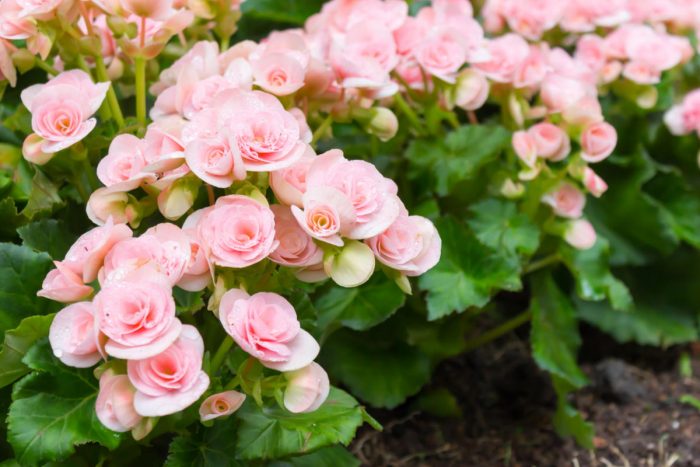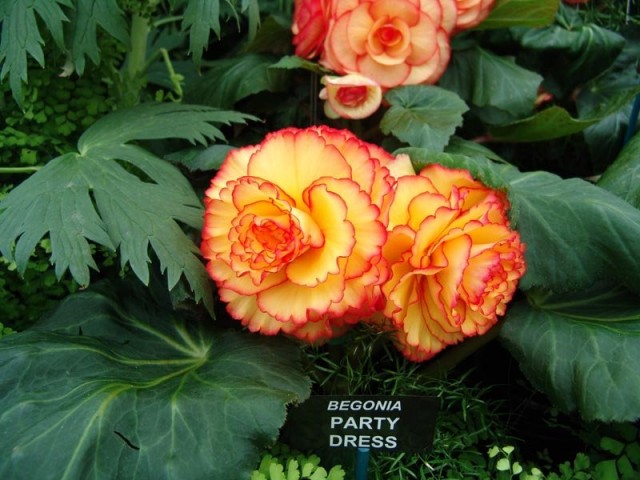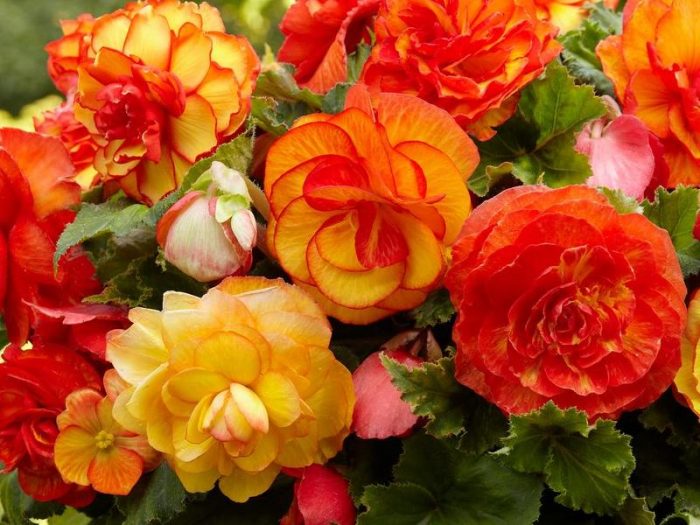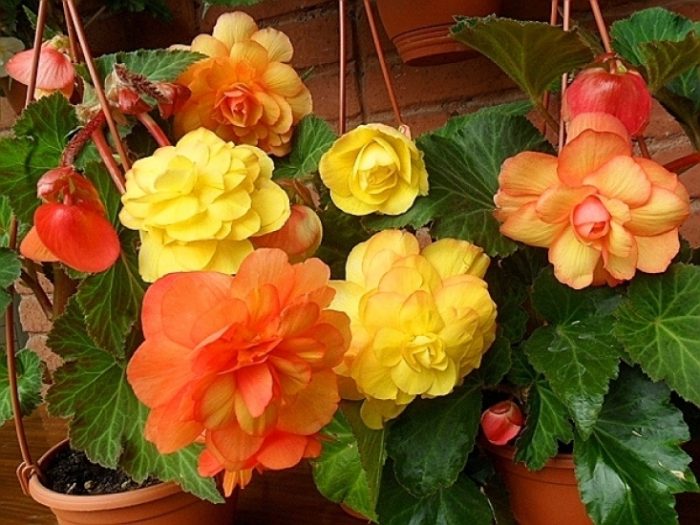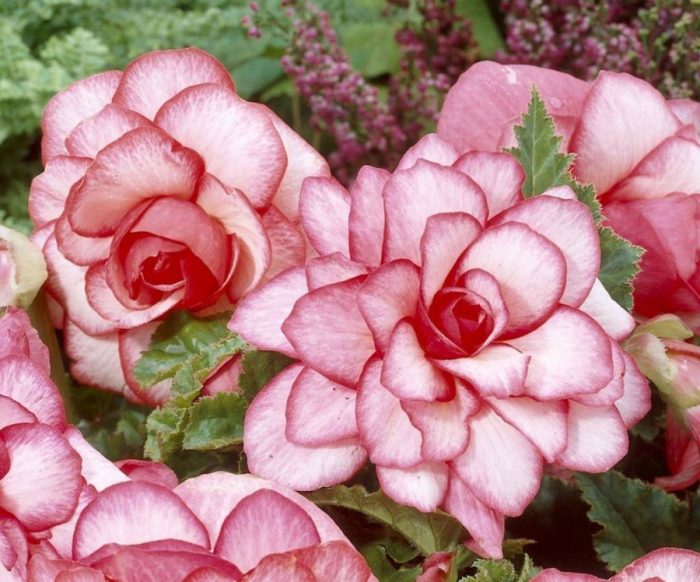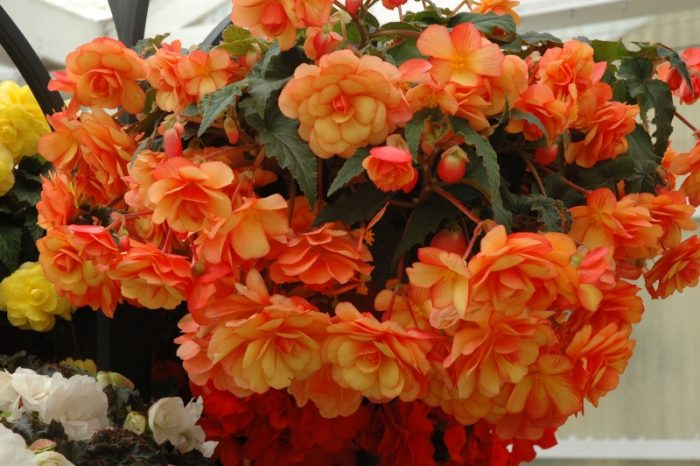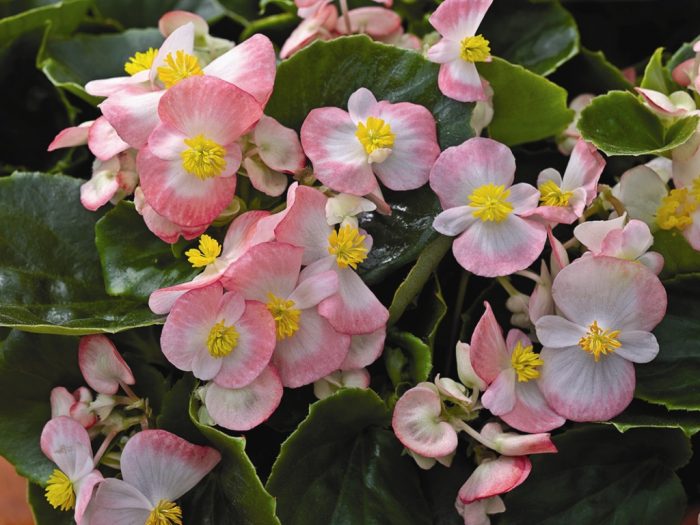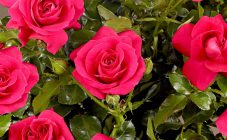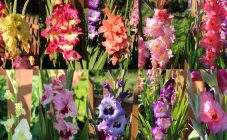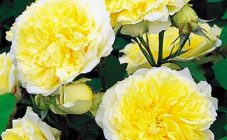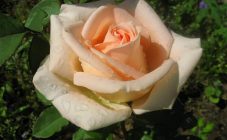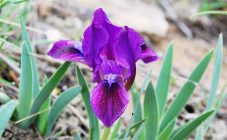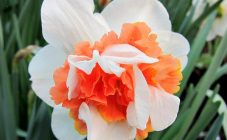Content:
Begonia is one of the brightest plants and is sure to please any grower. Experts identify more than 1,500 varieties of begonias, which differ in the color range of flowers, shape and size characteristics. The largest varieties can grow up to 300 cm, and miniature begonia reaches a height of no more than 5 cm. The native land of the exotic plant is Africa and South America. Begonia was named after the Governor of Haiti M. Begon.
Begonia can be found not only in the form of a herbaceous plant, but also in the form of a shrub and shrub. The most popular among flower growers are hybrids - the decorative-flowering and decorative-deciduous type of plant. Begonia whose varieties are diverse is suitable not only for experienced flower growers, but also for inexperienced summer residents who wish to decorate their site.
Top 10 popular varieties
The most popular varieties include:
- Party Dress is a tuberous variety that has a spectacular dazzling fiery palette. The inflorescences of the variety are quite large and terry. The color is distinguished by a harmonious transition. The dense inflorescences of the hybrid consist of flowers, the edges of which are endowed with ruffled outlines. The outer part of the petals is wide. Closer to the center, the petals taper. Their cruciform structure becomes clearer. The apricot orange hue of the flowers looks very rich. The outer part of the petal is colored with a thin reddish stripe, which is slightly blurred. The resulting contrast conveys the richness and warmth of the shade.
- Picotee Yellow-Red. The main difference between this plant variety is its two-tone color. Picotee Yellow-Red is a lush bloom in its compact size. The massiveness and density of the variety, whose height rarely exceeds 35 cm, is achieved thanks to the shortened peduncles. The diameter of the flowers is in the range of 8-9 cm. The dense double flowers look very elegant and become a real decoration of the yard. The petals of Picotee Yellow-Red look very unusual due to the apricot-melon shades with dark red edges. Densely arranged flowers merge into one motley spot. The greenery of the plant is painted in bright, cold colors, making the flowers look as impressive as possible.
- Camelia variety. Tuberous is distinguished by a unique shape of petals, thick double flowers that resemble camellia. The height of the bush reaches 28-30 cm. Small foliage emphasizes the large size of flowers, the diameter of which is in the range of 9-12 cm. The edges of the begonias are painted in white shades. Irregular spots turn into rich dark pink bases. This watercolorship of the classic form of flowers looks very attractive.
- Variety Marmorata vaguely resembles camellia, but differs from it in color. The red edges of the petals turn into a snow-white base with uneven strokes. Because of the variegated colors, Marmorata is often compared to a carnation, which is characterized by such patterns. Lush flowering. Marmorata Seed can be purchased at any specialty store.
- The Samba cultivar is a double-flowered large-flowered species that is distinguished by ruffled edges of the petals and bright shades of flowers, which can be either orange, white, pale pink, or cream, bright pink, yellow. The diameter of flowers often reaches 9-10 cm. Densely branching bushes look neat. Due to the shortened peduncles, there is a feeling that the flowers are sitting on foliage.
- Alkor F1 is a hybrid ampelous medicinal begonia that perfectly cleans the air. Alcor reaches a height of 40-45 cm. The foliage of the plant is dense, but the abundance of flowers that bloom on the bush literally covers all the greenery and creates a bright spot. Alcor flowers reach a diameter of 8 cm. Their elegance and asymmetry attract florists. The upper outer petals are tinted candy red. Bright pink streaks are clearly visible on the lower outer white petals. In the center of the flowers, the petals are delicately colored in delicate shades of pink and orange.
- Olomouc. This hybrid belongs to the ever-flowering ones. The main property of the plant is to reduce the content of staphylococcus in the air. The height of the bush barely reaches 20 cm, the diameter of the white flowers is within 2-3 cm. The dazzlingly bright foliage and compactness of a dense bush with ideal forms make Olomouc a popular variety. The flowers of the plant appear artificial from a distance. The rounded petals are curved to resemble the brim of a hat. The purity of the lines surprises no less than the bright radiance of the colors of the flowers. A lush ball, which is formed by orange stamens in the center, looks very impressive. Olomouc begins to bloom earlier than other plant varieties and pleases with its colorful flowers before the first frost.
- Archer - the petals are endowed with special tenderness. A large bright pink border effectively turns into a snow-white palette on the two central petals. Luchenets looks fresh, pastoral and very romantic.
- Splendide Ballerina is a compact shrub with a height of 25-30 cm. Hundreds of shades are combined in one plant. Large flowers cover the slightly reddish nondescript greenery. The diameter of flowers often reaches 10 cm. Each densely doubled flower is painted in salmon, pink, oil-yellow, peach, palette, apricot palette. The yellow tint gives the flowers a unique look. No description will convey all the beauty of the variety.
- Funky Pink is a new variety that is gaining more and more popularity every year. The new shape of the flowers resembles a chamomile with narrow petals and uneven terry. A thin pinkish pedicel, the elegance of narrow bright yellow stamens look quite attractive. The foliage of this variety is beautifully pointed, the shoots are strong enough, the flowers are lush and bright.
Such plant varieties as look no less impressive:
- begonia Griffin;
- begonia Camellia;
- Fista begonia;
- begonia the Black Prince;
- Kredner's begonia;
- Big begonia;
- Go go begonia;
- Begonia Midnight magic;
- Begonia Palomar prince;
- begonia Tamaya;
- big deluxe;
- begonia Black velvet;
- begonia Purple snow;
- begonia Black fang;
- Begonia Dark ed;
- mutata salt begonia;
- Escargot begonia;
- begonia Green goddess;
- begonia Pikoti;
- Miss Malibu begonia;
- Dollar down;
- begonia Maurice amy;
- begonia Raspberry torte;
- begonia Marmorata;
- Fimbriata;
- Chloroneura begonia;
- persian Ыwirl;
- Crisp;
- Pendula;
- Black Mamba;
- Peter piper begonia;
- Hallelujah;
- Black corduroy;
- Green gold begonia;
- Frances valentine begonia;
- begonia Raspberry swirl;
- Sal scomet;
- Sizemoreoe begonia;
- begonia Black Fang;
- Gloire Delorrain, care of which is absolutely simple;
- Begonia Mary Christmas;
- Kane;
- Palomar Prince;
- begonia Fista.
Growing begonias and care
Gourmet begonia is an absolutely unpretentious plant. Flowers growing in their natural environment can adapt to a variety of conditions. Flowers feel most comfortable in a medium shaded area with low humidity and acceptable temperature.
It is best to plant the plant in the garden in early June. During this period, the threat of frost will pass. For a flower, it is necessary to choose a shaded place or an area with diffused sunlight.
Plant propagation is carried out by cuttings.
Landing rules
Before planting a plant, it is important to carefully read the growing rules:
- Before the seedlings are planted in open ground, they should be hardened - the main condition that will help young bushes grow stronger. To do this, you will need to place them in a well-lit room for 7 days, the temperature in which is in the range of 22-26 ° C during the daytime, 12-15 ° C in the dark.
- For growing begonias, a soil mixture is suitable, which contains leafy earth, peat, sand and humus. The components should be combined in a ratio of 1: 0.5: 0.5: 0.5.
- After soil preparation, planting is carried out. A drainage mixture is poured onto the surface of the bottom of the hole, consisting of fine gravel, expanded clay or coarse sand. Then the hole is filled with a mixture of peat and compost. If desired, this mixture can be replaced with potassium-phosphorus fertilizer.
- After planting the seedling, it must be watered abundantly and the near-stem soil must be covered with wood ash. To avoid freezing of the soil in the dark, you can cover the ground with agrofibre or film material.
Lighting
Begonia needs soft lighting in the morning and evening. The large-leaved type of plant, painted in white, silver and red tones, is very picky about such lighting. In the cold season, it is worth placing flower pots on the south side. In the hot season, it is worth moving the pots to a shaded place so that the delicate foliage does not burn.
If the plants lack natural light, you can periodically turn on fluorescent phyto-lamps. Ever-flowering and deciduous flowers require 12 hours of daylight hours.
Temperature regime
The optimum temperature for growing begonias is between 18-19 ° C in the summer and 11-14 ° C in the cold season.
Humidity
According to the observations of specialists, the best development of indoor flowers of the Begonia family is observed when the air humidity is in the range of 50-55%. It is unacceptable to place pots with plants in close proximity to heating appliances, gas stoves or convectors. Combustion products that are thrown away by technology have a detrimental effect on flowers.
It is advisable to place an automatic humidifier near the begonia pot. If this is not possible, you can systematically spray water near the plant, exclude the lag from falling on the foliage. Moisturizing procedures should be carried out in the morning and evening hours.
Watering
A large number of plant varieties can perfectly withstand a short dry period. Excessive soil moisture, on the contrary, can lead to the occurrence of diseases and the death of the bush. The tuberous type of bush should be moistened when the substrate dries to half the depth. Branched, fibrous roots will need more fluid. For irrigation, you can use water that has settled or filtered. The water temperature should be at room temperature.
Fertilizers and feeding
Begonia needs systematic vitamin and mineral feeding. It is advisable to apply top dressing every 14 days from the beginning of spring to mid-autumn. In winter, the flowers are dormant.
In a specialized store, you can find a huge number of drugs that are produced for feeding begonias. They are made on the basis of a water-soluble complex of useful elements that enable bushes to maintain health during the active growth phase and during the flowering period.
Pests and diseases
By observing the basic rules for caring for flowers, you can avoid most of the problems that often arise among inexperienced flower growers.If the begonias are not kept properly, insects may appear on the plants or the bush may get sick. Very often you can find in begonia:
- dry foliage that occurs against the background of overdrying;
- the appearance of transparent spots on foliage is a sign of sunburn;
- collapse of greenery during hypothermia;
- rotting of the root system due to stagnant water;
- a decrease in the size of greenery and a decrease in the number of flowers is a consequence of a lack of minerals.
Powdery type spots on foliage most often appear with powdery mildew or gray mold. Ailments begin to develop against the background of a lack of light or with an increase in the level of humidity. You can fight diseases by spraying with fungicides, which contain benomyl.
You will have to get rid of the bushes even in those cases when nematodes (worms, the size of which is within 0.5-1 mm) start up in the root system and on the foliage of plants. The presence of worms can be recognized by surface deformation, the appearance of a swollen spot or build-up.
In cases where begonia is not well cared for, it can become infected with such pests:
- shield;
- thrips;
- red spider mite;
- aphid.
In order to cope with insects, you will need to apply insecticides. The treatment of a houseplant must be carried out near an open window to prevent air poisoning with chemical elements. If desired, you can spray the plant with soapy water (250 g of laundry soap is required for 10 liters of water). Onion and garlic infusions, tobacco can also save home bushes from pests. To maximize the effectiveness of treatment, the bushes will need to provide the correct climate in which the pests cannot exist.
Growing begonias is an interesting and very exciting process. Taking care of the bushes, you can soon enjoy the lush flowering of the plant.
